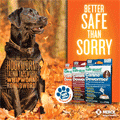Hunting Dog Training |
|
||

Featured Articles
The Waterfowling Dog - Creating A Great Conservation Tool
Take your dog. Sure, there are some waterfowl hunters out there debating whether a dog belongs in the blind, but there’s no doubt in the mind of Randy Bartz.(Continue)
Steadying Blues - An Interview with David Lauber Over the last two issues David Lauber has walked us through the process of steadying a dog to wing and shot. This month David addresses how to combat the "steadying blues", which faces many dogs during the steadying process. (Continue) Electronic Collar Training A few years ago I attended the Outdoor Writers Association of America’s annual conference on behalf of Nova Scotia Tourism. I had flown two of my dogs to the gathering, as I was scheduled to do some training exhibitions. The dogs performed admirably with tail wagging style, and after the event two members of the audience approached me. They complimented me on the dogs, then commented on how nice it was to see dogs trained without an electronic collar. (Continue) |
Take a Look Inside Our Online Store More Featured Articles
Wild Pheasants and Field Trial Dogs - Good or Bad?? – Part I
Here in North Dakota we have 3.5 million acres of CRP. CRP, for anyone unfamiliar, stands for Conservation Reserve Program. Through CRP, the Federal Agriculture Dept. contracts with farmers to place highly erodable cropland into a set aside program. CRP acres are planted to grass and left out of production for a minimum of ten years. This has created a boon to wildlife of all kinds, especially pheasants. Imagine hundreds of thousands of acres of knee to waist high grass-crawling with wild pheasants, sharp-tail grouse and Hungarian Partridge. Sounds like a dog trainer’s/field trialer’s/hunter’s dream? Well, it is, most of the time. (Continue) Crate Training As the owner of Woodland Kennel I am often clients ask, "What do you think about crate training?" My standard answer, "Crate training is the most misunderstood training technique a new dog owner faces today. Like most things in life, people often criticize what they don’t understand. Personally, I crate train all my dogs that live in the house. Many people have a misconception about what crate training is or what it is not." In this month’s article I will attempt to dispel some of the myths about crate training and give you some simple techniques that you can begin using today to make the process of crate training easy and create a "domestic den" for your dog. (Continue) The Swim-By The Swim-by is a fundamental step in the Basics portion of the program currently used by many successful retriever trainers across the continent. It gets its name from the skill developed by the dog at the end of the lessons: swimming by the handler on command. The Swim-by generally follows the teaching of the Double-T on land. That step prepares the dog for several of the skills that the dog will develop in the water. The Swim-by is an important pre-cursor to teaching your dog about water channels and water cheating singles. Novices, seeing the Swim-by for the first time often question the process of Swim-by and why it is necessary. Experienced trainers have learned that the Swim-by produces a dog with a readiness to stay in the water and a dog with important skills that make teaching advanced water work much easier. (Continue) |
Request a FREE Catalog Preparing a Retriever for Duck Hunting It’s never good when someone takes a young retriever duck hunting for the first time and then doesn’t understand why their pride and joy is picking up sticks in the water and grabbing the decoys and bringing them back instead of retrieving ducks. If that dog has never been in a duck blind before, it’s understandable to me, but hunters are always asking themselves, "Why isn’t my brand new well-bred, super expensive retriever sitting there like he’s supposed to, and retrieving like he’s supposed to; heck, he does it perfectly in the backyard."(Continue) The Three "S"s of Puppy Training: SHORT, SIMPLE and SUCCESSFUL! Acquire your pup at or around seven weeks of age. He needs to interact with his littermates until then, but should be separated from them by eight weeks of age. As soon as you get your pup, start teaching him "how to learn." A seven week old pup is very capable of learning. From seven to 16 weeks of age pups learn ’how to learn.’ It is a very important time frame in the life of your pup. Use it wisely. Remember, puppies cannot learn anything locked in a crate or left in a dog run. Your pup should become a part of your family and your life. (Continue) |
|
|
|
|||
Copyright ©2025 Geoffrey English - All Rights Reserved

 Manufacturers, Guides / Outfitters
Manufacturers, Guides / Outfitters
 Kennels and Trainers
Kennels and Trainers
 When you advertise with us you know you are reaching a targeted audience with a desire to learn more about training / caring for hunting dogs and who have a proven track record of purchasing hunting dog related supplies.
When you advertise with us you know you are reaching a targeted audience with a desire to learn more about training / caring for hunting dogs and who have a proven track record of purchasing hunting dog related supplies. 





















